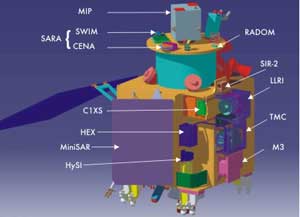|
Every satellite is composed of a bus, which is the set of systems that keeps it going, and a payload, which accomplishes the mission. The bus plays a supporting role and its functions include power generation and distribution, attitude control, and propulsion.
 |
| A diagram of payloads carried by Chandrayaan-1 |
The Chandrayaan-1 has 11 payloads, five of which are Indian while the remaining six are international.
INDIGENOUS PAYLOADS/EXPERIMENTS
Terrain Mapping Camera (TMC)
The aim of TMC is to map topography in both near and far side of the Moon and prepare a 3-dimensional atlas with high spatial and altitude resolution. Such high resolution mapping of complete lunar surface will help us understand the evolution process and allow detailed study of regions of scientific interests.
Hyper Spectral Imager (HySI)
The aim is to obtain spectroscopic data for mineralogical mapping of the lunar surface. The data from this instrument will help in improving the available information on mineral composition of the lunar surface. Also, the study of data in deep crater regions/central peaks, which represents lower crust or upper mantle material, will help in understanding the mineralogical composition of the Moon's interior.
Lunar Laser Ranging Instrument (LLRI)
The payload will help in providing ranging data for determining accurate altitude of the spacecraft above the lunar surface, determining the global topographical field of the Moon, obtaining an improved model for the lunar gravity field, and supplementing the data from terrain mapping camera and hyper-spectral imager payloads.
High Energy X-ray Spectrometer (HEX)
The High-Energy X-ray spectrometer covers the hard X-ray region from about 30 keV to about 250 keV. This is the first experiment to carry out spectral studies of planetary surface at hard X-ray energies using good energy resolution detectors. High Energy X-ray (HEX) experiment is designed primarily to study emission in the above energy range due to radioactive decay of the 238U and 232Th in the lunar surface region.
Moon Impact Probe (MIP)
The impact probe weighing 29 kg will ride piggyback on the top deck of the main orbiter and will be released at a pre-determined time after the orbiter reaches the final 100 km orbit to impact at a pre-selected location. During the descent phase it will be in a spin-stabilised configuration. The total flight time from release to impact on Moon will be close to 20 minutes. The major objectives are design, development and demonstration of technologies required for impacting a probe at a desired location on the moon; qualify technologies required for future soft landing missions and exploration of the Moon from close range.
INTERNATIONAL PAYLOADS
Chandrayaan-1 X-ray Spectrometer (C1XS)
The primary goal of the C1XS instrument is to carry out high quality X-ray spectroscopic mapping of the Moon in order to answer key questions on the origin and evolution of the Moon. C1XS would use X-ray fluorescence technique (1.0-10 keV) for measuring elemental abundance of magnesium, aluminum, silicon, calcium, iron and titanium distributed over the surface of the Moon.
Near-IR Spectrometer (SIR-2)
SIR-2 will address the surface-related aspects of lunar science in the following broad categories: analyse in unprecedented detail the lunar surface in various geological/mineralogical and topographical units; study the vertical distribution of crustal material; investigate the process of basin, maria and crater formation on the Moon; explore 'space weathering' processes of the lunar surface; survey mineral lunar resources for future landing sites and exploration. The determination of the chemical composition of a planet's crust and mantle is one of the important goals of planetary research.
Sub Kev Atom reflecting Analyser (SARA)
SARA will image the Moon surface using low energy neutral atoms as diagnostics in the energy range 10eV-2keV to address the following scientific objectives: imaging of the Moon's surface composition including the permanently shadowed areas and volatile rich areas; imaging of the solar wind surface interaction; imaging the lunar surface magnetic anomalies; studies of space weathering.
Radiation Dose Monitor Experiment (RADOM)
RADOM will qualitatively and quantitatively characterise, in terms of particle flux, dose rate and deposited energy spectrum, the radiation environment in near moon space. The specific objectives are: to measure the particle flux, deposited energy spectrum, accumulated absorbed dose rates in lunar orbit; provide an estimate of the dose map around Moon at different altitudes and latitudes; evaluate the shielding characteristics (if any) of the Moon near environment towards galactic and solar cosmic radiation and solar particle events; study the radiation hazards during the Moon exploration through the Chandrayaan-1 mission. Data obtained will be used for the evaluation of radiation environment and radiation shielding requirements on future manned Moon missions.
Miniature Synthetic Aperture Radar (MiniSAR)
The main objective is to detect water ice in the permanently shadowed regions on the lunar poles up to a depth of a few meters. Although lunar samples returned to the Earth show the Moon to be exceedingly dry, recent discoveries suggest that water ice may exist in the polar regions. MiniSAR is an onboard radar mapper that will allow viewing of all permanently-shadowed areas on the Moon.
Moon Mineralogy Mapper (M3)
M3 high-resolution mineral compositional maps will improve our understanding of the early evolution of a differentiated planetary body and also provide a high-resolution assessment of lunar resources. The scientific objective is to characterise and map lunar surface mineralogy in the context of lunar geologic evolution. This translates into several sub-topics relating to understanding the highland crust, basaltic volcanism, impact craters and potential volatiles. |



